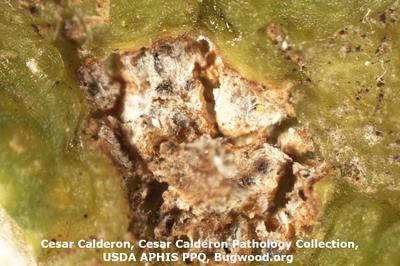Stemphylium Blight of Lentil
Pleospora herbarum
Fungus
In a Nutshell
- Small, light beige spots on leaves that coalesce to engulf entire branches.
- At high relative humidities, diseased leaves take on a gray to black appearance.
- Plants can be defoliated in a question of days.
- From the distance, irregular brownish patches are observed in the fields.
Can also be found in
Symptoms
Stemphylium blight initially appears as small, light beige spots on leaves or leaflets. These symptoms are very similar to those of botrytis blight. Eventually, these lesions coalesce to produce larger, irregularly shaped lesions that can engulf entire branches. Chlorotic to tan leaves are particularly conspicuous on the top of the canopy. Initially, stems remain green but as the disease progresses further, they eventually turn tan and then brown. At high relative humidities, diseased leaves take on a gray to black appearance. As they fall to the ground, they provide a new inoculum for future infections. Often, plants can be left with only terminal leaves in a question of days. From the distance, irregular brownish patches can be observed in the fields.
Recommendations

Organic Control
Aqueous extracts of Azadirachta indica (Neem) and Datura stramonium ( jimsonweed) can be used for the biocontrol of Stemphylium leaf blight disease with an efficacy close to that of conventional fungicides. Under greenhouse conditions, the preventive or curative application of products based on Trichoderma harzianum and Stachybotrys chartarum results in the reduction of disease incidence and severity (around 70% in both cases).

Chemical Control
Always consider an integrated approach with preventive measures and biological treatments if available. To be effective against Stemphylium blight of lentils, fungicides should be applied preventively in the last third of the growing season. Earlier treatments are bound to be ineffective. Solution of the active ingredients azoxystrobin + difenoconazole, boscalid + pyraclostrobin, chlorothalonil, iprodione, mancozeb and prochloraz could work well. Treatments should be done when conditions are unfavorable for the fungus (cool and dry weather). In general, the effectiveness of the fungicides was enhanced with an alternation of products.
What caused it?
Stemphylium blight of lentil is caused by the fungus Pleospora herbarum, formerly known as Stemphylium herbarum, thereby the name of the disease. It is thought to survive on seeds or infected dead plant debris in the field. Beside lentil, this fungus can infect a wide range of other bloadleaf plants. An extended period of leaf wetness late in the season is essential for the development of the disease. The incidence and severity of symptoms also depends on temperatures, with the range 22 -30°C being optimal. In these conditions, 8 to 12 hours of leaf moisture are enough to trigger infection. In suboptimal conditions, for example air temperatures of 15 to 20 °C, the length of the moisture period can increase substantially (24 hours or more). Older plants are more susceptible to develop the disease than younger ones, particularly when they are under nitrogen stress.
Preventive Measures
- Make sure to select clean seeds, if possible from certified source.
- Select resistant varieties (several are available).
- Reduced plant density to have a good airflow.
- Ensure a good field drainage before planting.
- Avoid excessive nitrogen applications which can increase disease severity.
- Remove and bury plant debris through tillagen after harvest.


